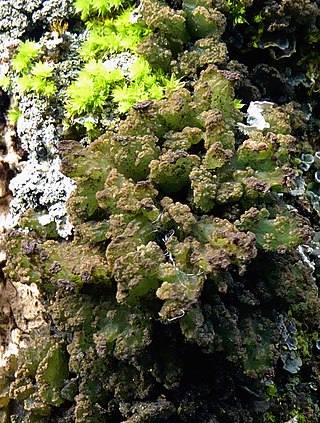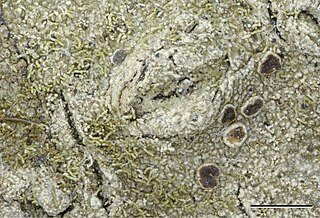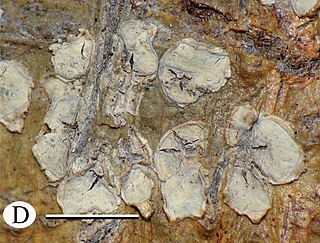
The Cladoniaceae are a family of lichenized fungi in the order Lecanorales. It is one of the largest families of lichen-forming fungi, with about 560 species distributed amongst 17 genera. The reindeer moss and cup lichens (Cladonia) belong to this family. The latter genus, which comprises about 500 species, forms a major part of the diet of large mammals in taiga and tundra ecosystems. Many Cladoniaceae lichens grow on soil, but other can use decaying wood, tree trunks, and, in a few instances, rocks as their substrate. They grow in places with high humidity, and cannot tolerate aridity.

The Graphidaceae are a family of lichen-forming fungi in the order Graphidales. The family contains nearly a hundred genera and more than 2000 species. Although the family has a cosmopolitan distribution, most Graphidaceae species occur in tropical regions, and typically grow on bark.
The Agyriaceae are a family of lichenized fungi in the order Pertusariales. It contains two genera: Agyrium, and Miltidea. The family was circumscribed by August Carl Joseph Corda in 1838.

Fissurina is a genus of lichenized fungi in the family Graphidaceae. It has about 160 species, most of which are found in tropical regions.

Lecanographa is a genus of about 40 species of lichens in the family Lecanographaceae. It was circumscribed in 1994 by José M. Egea and Pilar Torrente, with Lecanographa lyncea as the type species.

The Arctomiaceae are a family of lichenized fungi in the Ascomycota, class Baeomycetales. The family was named by Theodor Magnus Fries in 1861, with Arctomia as the type genus. Species in this family are found in arctic and subarctic habitats, usually associated with bryophytes.

Neoprotoparmelia is a genus of crustose lichens that was created in 2018. It contains 24 tropical and subtropical species that mostly grow on bark. Neoprotoparmelia is in the subfamily Protoparmelioideae of the family Parmeliaceae, along with the morphologically similar genera Protoparmelia and Maronina.

Trichotheliaceae is a family of lichen-forming fungi in the order Gyalectales. The family was circumscribed by Friedrich von Schilling and Friedrich August Georg Bitter in 1927.

Schaereria is a genus of lichen-forming fungi. It is the sole genus in the family Schaereriaceae, which itself is the only family in the Schaereriales, an order in the subclass Ostropomycetidae of the class Lecanoromycetes.

Leprocaulaceae is a family of mostly lichen-forming fungi. It is the single family in the monotypic order Leprocaulales. Leprocaulaceae contains three genera and about 33 species.

Rhizocarpales are an order of lichen-forming fungi in the subclass Lecanoromycetidae of the class Lecanoromycetes. It has two families, Rhizocarpaceae and Sporastatiaceae, which contain mostly crustose lichens.

Sporastatia is a genus of crustose lichens in the family Sporastatiaceae. It has four species. Sporastatia lichens are long-lived species that grow on siliceous or weakly calcareous rocks in arctic and alpine locales.

Astrochapsa is a genus of lichen-forming fungi in the subfamily Graphidoideae of the family Graphidaceae. It has 28 species. The genus was circumscribed by Sittiporn Parnmen, Robert Lücking, and H. Thorsten Lumbsch in 2012, with Astrochapsa astroidea assigned as the type species. It was segregated from the genus Chapsa, from which it differs in having a more frequently densely corticate thallus, an apothecial margin that is mostly recurved, and the almost exclusively subdistoseptate, non-amyloid ascospores.
Myriochapsa is a genus of corticolous (bark-dwelling), crustose lichens in the subfamily Graphidoidae of the family Graphidaceae. It has three species. The genus was circumscribed in 2013 by Marcela Cáceres, Robert Lücking, and H. Thorsten Lumbsch, with the Brazilian Myriochapsa psoromica assigned as the type species. The generic name combines Myriotrema and Chapsa, referring to the two Graphidaceae genera that it resembles. The main distinguishing characteristics of the new genus are its densely corticate thallus, and the presence of the lichen product psoromic acid. Additionally, its apothecia have wider pores, with differently textured margins. Although originally created as a monotypic genus, Harrie Sipman added two South American species in 2014.

Sarrameanaceae is a family of lichen-forming fungi in the monotypic order Sarrameanales. It contains two genera, Loxospora, and Sarrameana, the type genus. The family was circumscribed by Josef Hafellner in 1984. The order Sarrameanales was proposed by Brendan Hodkinson and James Lendemer in 2011, as they had noted that previously published large-scale molecular phylogenetic studies had shown that the group of species contained in the family Sarrameanaceae were distinct and separate from the clade containing all of the other orders of the Ostropomycetidae. However, the name Sarrameanales was not validly published according to the rules of botanical nomenclature, because it was not accompanied by a suitable description. Despite this, the order continues to be used in lichenological literature.
Thelenellaceae is a family of lichen-forming fungi. It is the sole family in the monotypic order Thelenellales, and contains three genera and about 50 species.
Amazonotrema is a monotypic genus of lichenised fungi in the family Graphidaceae. It was circumscribed in 2009 by Klaus Kalb and Robert Lücking for the species Amazonotrema nigrum. The type specimen of A. nigrum was collected from virgin rainforest along the Rio Negro in the Brazilian state of Amazonas.

Robert Lücking is a German lichenologist. He is a leading expert on foliicolous lichens–lichens that live on leaves.
Graphidales is an order of lichen-forming fungi in the class Lecanoromycetes. It contains 6 families, about 81 genera and about 2,228 species. Family Graphidaceae are the largest crustose family within Graphidales order comprising more than 2000 species, which are widely distributed in tropical and subtropical regions of the world.
Redonographa is a genus of lichen-forming fungi in the monogeneric family Redonographaceae. It has five species.













